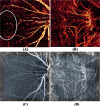High-resolution wide-field imaging of retinal and choroidal blood perfusion with optical microangiography
- PMID: 20459256
- PMCID: PMC2859086
- DOI: 10.1117/1.3369811
High-resolution wide-field imaging of retinal and choroidal blood perfusion with optical microangiography
Abstract
We present high-resolution wide-field imaging of retinal and choroidal blood perfusion with optical microangiography (OMAG) technology. Based on spatial frequency analysis, OMAG is capable of visualizing the vascular perfusion map down to capillary-level resolution. An OMAG system operating at 840 nm is used with an A-scan rate of 27,000 Hz, axial resolution of 8 mum, and sensitivity of 98 dB. To achieve wide-field imaging, we capture 16 optical coherence tomography (OCT) 3-D datasets in a sequential order, which together provide an area of approximately 7.4 x 7.4 mm(2) at the posterior segment of the human eye. For each of these datasets, the bulk tissue motion artifacts are eliminated by applying a phase compensation method based on histogram estimation of bulk motion phases, while the displacements occurring between adjacent B-frames are compensated for by 2-D cross correlation between two adjacent OMAG flow images. The depth-resolved capability of OMAG imaging also provides volumetric information on the ocular circulations. Finally, we compare the clinical fluorescein angiography and indocyanine green angiography imaging results with the OMAG results of blood perfusion map within the retina and choroid, and show excellent agreement between these modalities.
Figures










References
-
- Kwiterovich K. A., Maguire M. G., Murphy R. P., Schachat A. P., Bressler N. M., Bressler S. B., and Fine S. L., “Frequency of adverse systemic reactions after fluorescein angiography. Results of a prospective study,” Ophthalmology OPHTDG 98, 1139–1142 (1991). - PubMed
-
- Hope-Ross M., Yannuzzi L., Gragoudas E., Guyer D., Slakter J., Sorenson J., Krupsky S., Orlock D., and Puliafito C., “Adverse reactions due to indocyanine green,” Ophthalmology OPHTDG 101, 529–533 (1994). - PubMed
-
- Fercher A. F., Drexler W., Hitzenberger C. K., and Lasser T., “Optical coherence tomography—principles and applications,” Rep. Prog. Phys. RPPHAG 66, 239–303 (2003).10.1088/0034-4885/66/2/204 - DOI
-
- Tomlins P. H. and Wang R. K., “Theory, development and applications of optical coherence tomography,” J. Phys. D Appl. Phys. 38, 2519–2535 (2005).10.1088/0022-3727/38/15/002 - DOI
Publication types
MeSH terms
Grants and funding
LinkOut - more resources
Full Text Sources
Other Literature Sources
Miscellaneous

